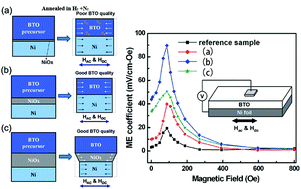Role of the interface on the magnetoelectric properties of BaTiO3 thin films deposited on polycrystalline Ni foils
Abstract
BaTiO3 (BTO) thin films were deposited on polycrystalline Ni foils using a chemical solution approach. We show that the interface between the BTO film and the Ni foil plays a critical role in determining the magnetoelectric (ME) properties of this flexible assembly, which is likely to be related to the evolution of nickel oxide at the interface during the growth of BTO films. Our results have demonstrated that not only a well-controlled interface between the BTO film and the Ni substrate can be achieved, but also an ME voltage coefficient as large as 90 mV cm−1 Oe−1 can be accomplished.


 Please wait while we load your content...
Please wait while we load your content...